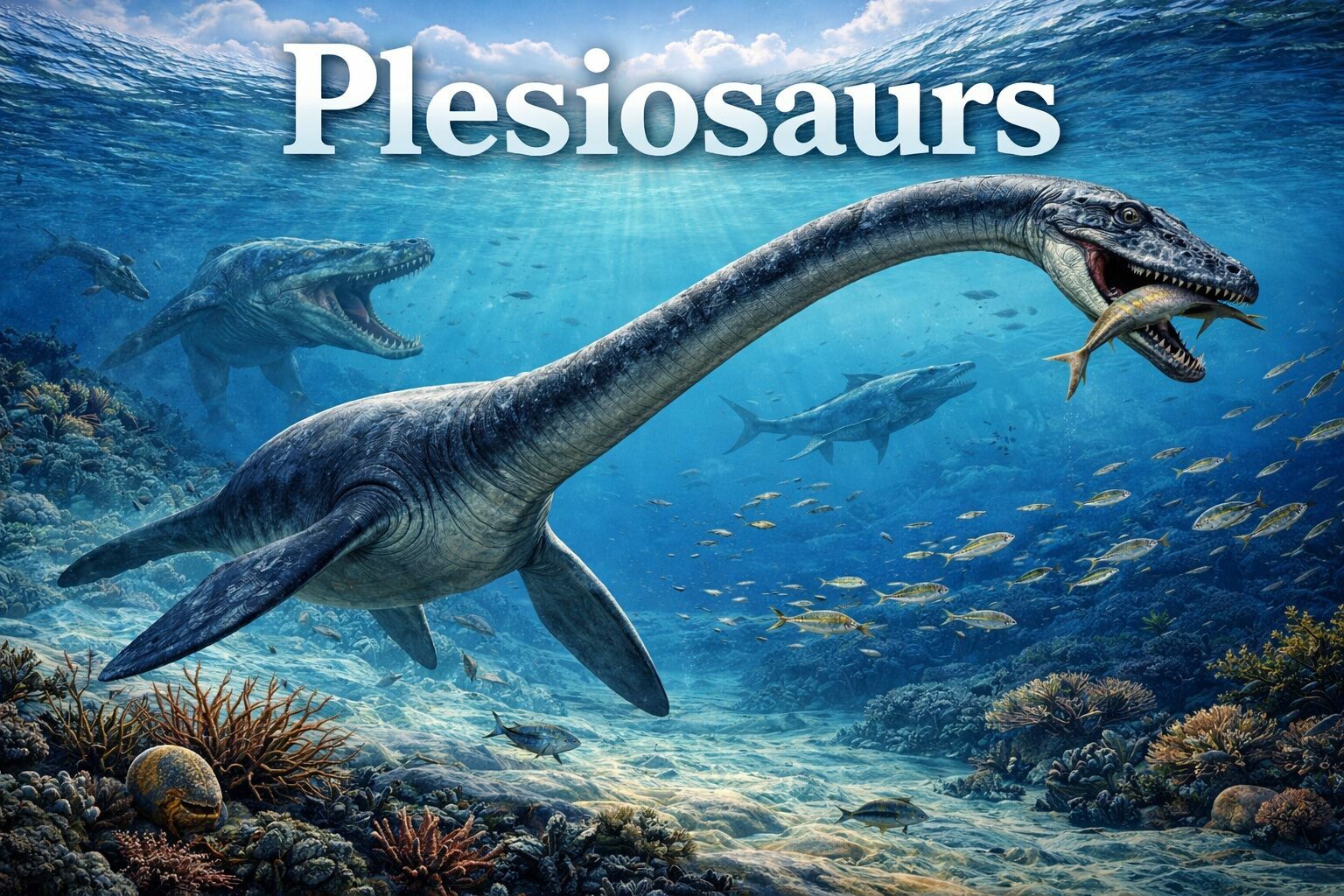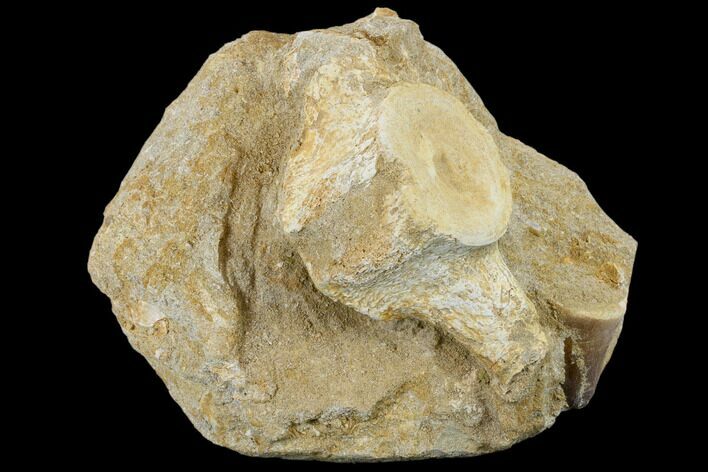This Specimen has been sold.
4.3" Plesiosaur Caudal Vertebra And Mosasaur Tooth - Morocco
This is a 4.3" wide Plesiosaur caudal vertebra from the Upper Cretaceous phosphate deposits in the Oulad Abdoun Basin of Morocco. It is in good condition on the sandstone in which it was found. The left transverse is largely intact with the base of the right transverse process also present. The spinal process is missing. In addition there is a Mosasaur tooth. The rock contains unidentified bone and shell material.
About Plesiosaurs
Plesiosaurs were a diverse group of marine reptiles that lived during the Jurassic and Cretaceous periods, thriving in Earth’s oceans for more than 135 million years. Although they lived alongside dinosaurs, plesiosaurs were not dinosaurs; instead, they were fully aquatic reptiles adapted for life in open water. Their most recognizable features included broad, streamlined bodies, four powerful flippers used for underwater “flight,” and a wide range of neck lengths. Fossils of plesiosaurs have been found on every continent, including Antarctica, showing that they inhabited oceans across the globe.

This group included two main body types that filled very different ecological roles. Long-necked plesiosaurs had small heads and slender teeth suited for catching fish and squid, likely relying on stealth and precise strikes. Short-necked plesiosaurs, known as pliosaurs, evolved massive skulls and powerful jaws and became apex predators capable of hunting large prey, including other marine reptiles. Together, these forms made plesiosaurs one of the most successful and adaptable marine reptile groups in Earth’s history, dominating prehistoric seas until their extinction at the end of the Cretaceous.
Plesiosaurs were a diverse group of marine reptiles that lived during the Jurassic and Cretaceous periods, thriving in Earth’s oceans for more than 135 million years. Although they lived alongside dinosaurs, plesiosaurs were not dinosaurs; instead, they were fully aquatic reptiles adapted for life in open water. Their most recognizable features included broad, streamlined bodies, four powerful flippers used for underwater “flight,” and a wide range of neck lengths. Fossils of plesiosaurs have been found on every continent, including Antarctica, showing that they inhabited oceans across the globe.

This group included two main body types that filled very different ecological roles. Long-necked plesiosaurs had small heads and slender teeth suited for catching fish and squid, likely relying on stealth and precise strikes. Short-necked plesiosaurs, known as pliosaurs, evolved massive skulls and powerful jaws and became apex predators capable of hunting large prey, including other marine reptiles. Together, these forms made plesiosaurs one of the most successful and adaptable marine reptile groups in Earth’s history, dominating prehistoric seas until their extinction at the end of the Cretaceous.
Mosasaurs were a family of enormous marine reptiles that truly dominated the seas 90 million years ago, ruling during the last 20-25 million years of the Cretaceous period. With the extinction of the ichthyosaurs and decline of plesiosaurs, mosasaurs diversified to become prolific apex predators in nearly every habitat of the oceanic world.
Larger mosasaurs were the great leviathans of their time, extending 10–15 meters, or 33–49 feet long. Hainosaurus holds the record for the longest mosasaur at a seemingly impossible 57 feet. The smaller genera were still an impressive 10–20 feet long.
Mosasaurs probably evolved from semi-aquatic scaled reptiles, perhaps more similar in appearance to modern-day monitor lizards. They had double-hinged jaws and flexible skulls much like that of a snake which enabled them to gulp down their prey almost whole.
The gruesome unchewed contents of fossilized mosasaur guts have revealed a varied diet of sea birds, ammonites, smaller marine lizards, possibly sharks, and even other mosasaurs. Ammonites were especially crunchy mosasaur treats. They were abundant in the Cretaceous seas, and some mosasaurs had specialized teeth for the job.
Mosasaurs probably lurked for an ambush, rather than hunt, using their powerful tail flukes for extra thrust to dart out and swallow unsuspecting prey. Non-reflective, keeled scales may have been a great advantage to the mosasaur sneak-attack.
Mosasaurs breathed air and gave birth to live young. The bronchi leading to the lungs run parallel to each other, instead of splitting apart from one another as in monitors and other terrestrial reptiles. They were well-adapted to living in the warm, shallow, epicontinental seas of the period.
Although mosasaurs diversified and proliferated at a spectacular rate, their specialization is considered the source of their demise when marine systems collapsed at the end of the Cretaceous.
Larger mosasaurs were the great leviathans of their time, extending 10–15 meters, or 33–49 feet long. Hainosaurus holds the record for the longest mosasaur at a seemingly impossible 57 feet. The smaller genera were still an impressive 10–20 feet long.
Mosasaurs probably evolved from semi-aquatic scaled reptiles, perhaps more similar in appearance to modern-day monitor lizards. They had double-hinged jaws and flexible skulls much like that of a snake which enabled them to gulp down their prey almost whole.
The gruesome unchewed contents of fossilized mosasaur guts have revealed a varied diet of sea birds, ammonites, smaller marine lizards, possibly sharks, and even other mosasaurs. Ammonites were especially crunchy mosasaur treats. They were abundant in the Cretaceous seas, and some mosasaurs had specialized teeth for the job.
Mosasaurs probably lurked for an ambush, rather than hunt, using their powerful tail flukes for extra thrust to dart out and swallow unsuspecting prey. Non-reflective, keeled scales may have been a great advantage to the mosasaur sneak-attack.
Mosasaurs breathed air and gave birth to live young. The bronchi leading to the lungs run parallel to each other, instead of splitting apart from one another as in monitors and other terrestrial reptiles. They were well-adapted to living in the warm, shallow, epicontinental seas of the period.
Although mosasaurs diversified and proliferated at a spectacular rate, their specialization is considered the source of their demise when marine systems collapsed at the end of the Cretaceous.
SPECIES
Plesiosaur sp, Mosasaur sp.
AGE
LOCATION
Oulad Abdoun Basin, Morocco
FORMATION
Phosphate Deposits
SIZE
4.3" wide (including process), 1.3" tooth, 5.9 x 4.8" rock
CATEGORY
SUB CATEGORY
ITEM
#113828
We guarantee the authenticity of all of our specimens.
 Reviews
Reviews














